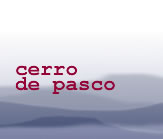THEMES IN THIS
TESTIMONY
Culture and Customs

Development

History

Industry

Migration

Social Change

Social Relationships

Click on arrows
to find more
testimonies
featuring
these themes
|
|
Sex
|
male
|
|
|
Age
|
51
|
|
|
Occupation
|
carpenter
|
|
|
Location
|
La Oroya
|
|
|
Date
|
1995
|
|
summary
Amador is a real Oyorino, whose memories of the place stretch back to those of his grandparents. He feels strongly rooted there and even though, as craftsman with a small business, he could find make a living elsewhere, away from the fumes and blasted landscape of the smelter, he prefers to stay put.
The smelter was built in his grandparents’ days – he says the company misled people and implied they were building a textile processing plant. Gradually the pollution got worse. His grandparents’ generation resisted employment in the plant: “it was as if you were serving the enemy.” But later generations felt that they’d never be able to close the company down, and started taking jobs there. More divisions happened when some communities got compensation. Some people moved elsewhere to invest their compensation; some stayed. As, like many others, his father could no longer work in agriculture, he took up carpentry and Amador followed suit.
His children are in higher education; one son studies industrial engineering. It seems he has left La Oroya, but Amador feels that even from afar, the new generation can “contribute to its development”. He feels one can’t ask them to stay – “The parents... the older generation must understand that things have changed, that things are not like they used to be, now is different, and people leave to find new opportunities.” – but they can still help the community move forward. One of the biggest problems, he feels, is that the mining industry has always been owned by foreigners or outsiders from Lima. Local people need to take it over, and local sons and daughters, even if they leave the region for education and work, can use their expertise to help make it work.
detailed breakdown
|
You will need a password from Panos to view the full
transcript of the interview. To apply for a password, click here.
Once you have a password, click here to go to the beginning
of the transcript. You can also click on any section of the
breakdown of content below and go straight to the
corresponding part of the transcript.
|
| Section 1 |
Family history; the impact of the smelter; the fact that it is a painful history, because the environmental decline, which continued to accelerate, began with at the time of his grandparents
|
| Section 2 |
People didn’t realise exactly what was going to be built or what the impact would be; reaction came too late.
|
| Section 3 |
He went to metallurgical school, which had links with the industry. Even though they were studying the subject, and in line for jobs, they were still questioning the pollution, but didn’t speak out.
Talks about the company scientists, the gringos (North Americans who ran/owned the mines), and an abortive move to shift the smelter chimney to higher land.
|
| Section 4 |
Some compensation settlements were reached, but ultimately feels the land and the people have been destroyed by the industry. Glad that he went into the carpentry business.
|
| Section 5-6 |
His children are in higher education. Recognises that they may stay in Lima and feels that must be their choice. Sad and resigned to migration, but believes they don’t forget their roots and: “I think that our young Oyorino professionals, even though they don’t live in this city, they can contribute to its development. That we can expect of them, but to ask them to stay or to leave, that we can’t.” Not only was the drift away from La Oroya previously much less, people actually migrated in. Mining is a valuable resource but should enrich everyone, not just a few and make life worse for the rest as now. Story of the place name.
|
| Section 7 |
Talks of festivals and dances and other customs, some intact, some changing.
|
| Section 8 |
But biggest change is that La Oroya is no longer a campesino community but a mining one. The earlier in-migration (of “foreigners”) also changed it.
|
| Section 9 |
He loves the city, his birthplace, and won’t leave. But there’s anxiety too – what will happen when Centromin is privatised? “The day the smelter disappears, the city will disappear.” It needs to be modernised, not closed.
Cites the potential for small businesses, and the need to improve the contaminated environment.
|
| Section 10 |
If the company could be owned by the local people, instead of outsiders, then they would have a real commitment to improving the management and reducing the pollution. Above all, “the people are tired of hearing that they are a mining community and that they do not receive anything except fumes.”
|
|


